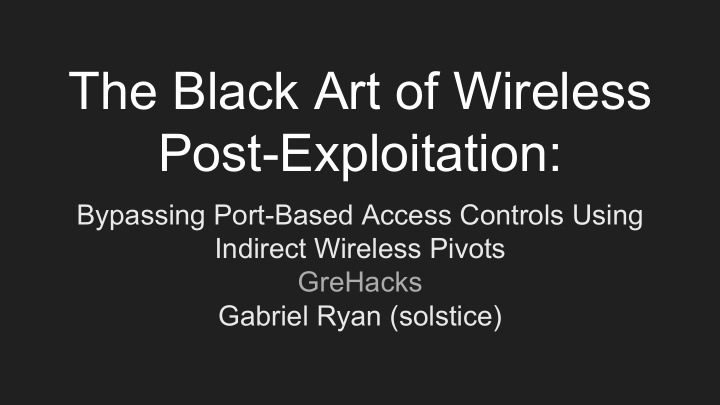



LLMNR/NBT-NS Poisoning Two Windows computers named Alice and Leeroy [23]: 1. Alice wants to request file from Leeroy, but does not know Leeroy’s IP 2. Alice attempts to resolve Leeroy’s name locally and using DNS, but fails 3. Alice makes broadcast requests using LLMNR/NBT-NS 4. Every computer on Alice’s subnet receives request 5. Honor system: only Leeroy responds
LLMNR/NBT-NS Poisoning No honor among thieves [23]: 1. If Alice receives two responses, first one is considered valid 2. Creates race condition 3. Attacker waits for LLMNR/NBT-NS queries, responds to all of them 4. Victim sends traffic to the attacker
Review: Redirect to SMB
Redirect to SMB § The idea is to force the victim to visit an HTTP endpoint that redirects to an SMB share on attacker’s machine, triggering NTLM authentication § Variation: redirect to non-existent SMB share, triggering LLMNR/NBT-NS [24] § Fast way to get hashes § Requires social engineering
Hostile Portal Attacks
Steal Active Directory creds from wireless network without network access .
Captive Portal § Used to “restrict” access to an open WiFi-network
Captive Portal § All DNS queries resolved to captive portal § All DNS traffic redirected to captive portal (optional) § All HTTP traffic redirected to captive portal (optional)
Hostile Portal Attack § Based on Redirect to SMB Attack § Victim forced to connect to attacker using Rogue AP attack § All HTTP traffic redirected to SMB share on attacker’s machine instead of a captive portal attack § All LLMNR/NBT-NS lookups are poisoned
WPA-EAP networks: In most cases, this means EAP-TTLS or EAP-PEAP. § Both use MS-CHAPv2 as the inner authentication method. § Mutual authentication: the RADIUS server must prove knowledge of the supplicant’s password for inner authentication to succeed [29]
WPA-EAP networks: What this means: § Although the attacker can force the victim to authenticate with an evil twin to steal hashes, the attacker’s RADIUS server will fail the final the final stage of the authentication process and the client will not associate with the attacker [29].
Solution: Crack credentials offline: 1. Weak RADIUS Passwords: Use auto crack ‘n add technique (Dominic White & Ian de Villiers in 2014) 2. Strong RADIUS Passwords: Crack offline, finish attack later
Auto Crack ‘N Add (Dominic White & Ian de Villiers)
Second Option: Crack offline, Pwn later No caveats other than time. Dictionary attack: lifecycle of the attack now § takes place over the course of a week, rather than an hour. Divide and Conquer: 24 hours max when § using FPGA based hardware, 100% success rate
What this gets you: lots and lots of NTLM hashes Similar results to LLMNR/NBT-NS poisoning, but with a few key advantages: § No network access required § Not limited to a local subnet (you get everything that is connected to wireless) § Not a passive attack
Back to our scenario...
Indirect Wireless Pivots
Use Rogue Access Point attacks to bypass port-based access control mechanisms
Hashes cracked offline…
Recommend
More recommend